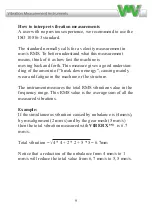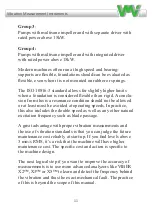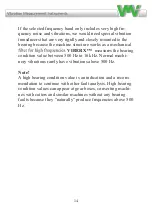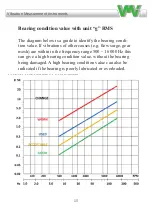
Vibration Measurement Instruments
Battery check
VIBER X1™ has an embedded battery check, when less than 10 %
of the battery capacity remains, the battery LED will fl ash.
Press this symbol key and the measurement of bearing condition
will start. The instrument measures instantaneously a bearing
condition value in the range between 500 Hz to 20.000 Hz.
To go back to vibration measurements, press the symbol once
more.
Placing of the measuring point
The measurements should be taken on or as close to the bearing as
possible and in horizontal, vertical and axial directions.
Bearing condition
Manual Viber X1_121002.indd 6
10/3/12 9:26 AM
Measuring point location
Measurements should be taken on the bearing housing or as
close as possible and in the horizontal, vertical and axial direc-
tions. This is also explained in the standard ISO-10816.
6
V
V
Vibration Measurement Instruments
Functions
Press the start key and the instrument starts to measure
vibration, default is 2 – maximum frequency range, the diodes
indicates low and high pass fi lters setting.
The instrument will be shut off automatically after approximately
4 minutes if no key are used during the time.
This button can be used if the digits need a higher brightness to be
more visible.
The Viber X1™ is one of few analogical instrument that has
adjustable frequency ranges. To measure in other frequency
range, use the up/down arrows to change the fi lters. The fi lters
LED will light up to show the fi lter in use. This can be a useful
feature; comparison can be done with measurements in the
same range. Notice that the old ISO standard had 10 -1000 Hz
as frequency range. We recommend you to use 2 – 1000 Hz
as a standard range.
Start of the instrument
Improving the light
Changing frequency range
Manual Viber X1_121002.indd 5
10/3/12 9:26 AM




















